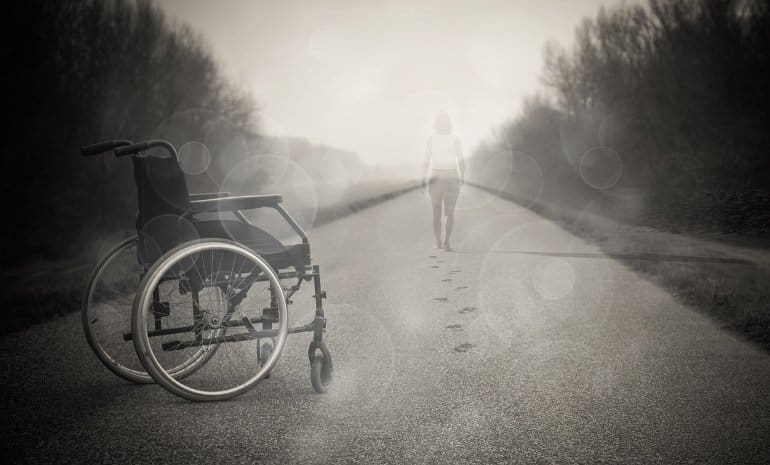Summary: Stimulating glutamatergic neurons in the cuneiform nucleus may improve walking recovery in those with spinal cord injury.
Source: Université Laval
People who have lost control of their legs following a spinal cord injury may walk again someday. A research team affiliated with Université Laval and the CHU de Québec-Université Laval Research Center has pinpointed a new neurological target that could improve the recovery of gait.
Contrary to popular belief, spinal cord injuries are rarely complete. The brain retains access to the spinal cord circuitry below the lesion, but this connection is often dormant. Deep brain stimulation, or electrical stimulation, could activate it and promote recovery of locomotion. But which area of the brain should be targeted?
A research team led by Frédéric Bretzner, a professor at a professor at Université Laval’s Faculty of Medicine, has focused on a locomotor center of the brain known as the mesencephalic locomotor region. This area is known as a trigger and accelerator for walking in several animal species. It is composed of the cuneiform nucleus and the pedunculopontine nucleus.
Deep brain stimulation of the pedunculopontine nucleus has generated ambiguous results in Parkinson’s patients with gait and postural disorders. However, there are no clinical studies on the cuneiform nucleus.
A Promising Area of the Brain
Professor Frédéric Bretzner’s team used optogenetics to modify neurons to make them light-sensitive. The team then used blue light to activate glutamatergic, or excitatory, neurons in the cuneiform or pedunculopontine nucleus in mice.
“After spinal cord injury, stimulation in the cuneiform nucleus of excitatory neurons initiated walking in resting mice. During a spontaneous walking episode, stimulation also improved the quality of the mouse’s walk and the coordination between the muscles of its hind legs,” explains Frédéric Bretzner.

Conversely, the stimulation of glutamatergic neurons in the pedunculopontine nucleus rarely triggered walking in mice at rest. Stimulation even caused mice to stop when they walked.
“Our results suggest that the cuneiform nucleus would be a better neurological target than the pedunculopontine nucleus to improve walking recovery in people with a spinal cord injury,” reports Professor Bretzner.
While waiting for the development of implants and optogenetic tools adapted to target glutamatergic neurons of the cuneiform nucleus in humans, electrical stimulation of the cuneiform nucleus could already improve walking recovery in patients with spinal cord injury.
This approach could also improve the quality of life of individuals suffering from traumas or neurodegenerative diseases affecting gait and posture, such as stroke, amyotrophic lateral sclerosis, or Parkinson’s disease.
About this neurology research news
Author: Audrey-Maude Vézina
Source: Université Laval
Contact: Audrey-Maude Vézina – Université Laval
Image: The image is in the public domain
Original Research: Open access.
“Functional contribution of mesencephalic locomotor region nuclei to locomotor recovery after spinal cord injury” by Frédéric Bretzner et al. Cell Reports Medicine
Abstract
Functional contribution of mesencephalic locomotor region nuclei to locomotor recovery after spinal cord injury
Highlights
- Glutamatergic CnF is more important than PPN to spontaneous motor recovery
- Glutamatergic CnF contributes more efficiently than PPN to spontaneous recovery
- Only activation of glutamatergic CnF initiates locomotion after chronic SCI
- Only activation of glutamatergic CnF improves stepping ability after chronic SCI
Summary
Spinal cord injury (SCI) results in a disruption of information between the brain and the spinal circuit. Electrical stimulation of the mesencephalic locomotor region (MLR) can promote locomotor recovery in acute and chronic SCI rodent models.
Although clinical trials are currently under way, there is still debate about the organization of this supraspinal center and which anatomic correlate of the MLR should be targeted to promote recovery.
Combining kinematics, electromyographic recordings, anatomic analysis, and mouse genetics, our study reveals that glutamatergic neurons of the cuneiform nucleus contribute to locomotor recovery by enhancing motor efficacy in hindlimb muscles, and by increasing locomotor rhythm and speed on a treadmill, over ground, and during swimming in chronic SCI mice. In contrast, glutamatergic neurons of the pedunculopontine nucleus slow down locomotion.
Therefore, our study identifies the cuneiform nucleus and its glutamatergic neurons as a therapeutical target to improve locomotor recovery in patients living with SCI.







